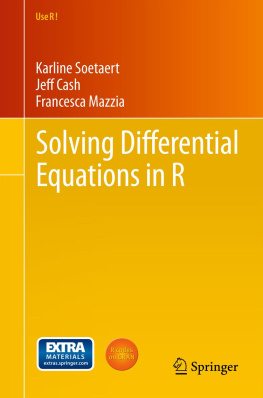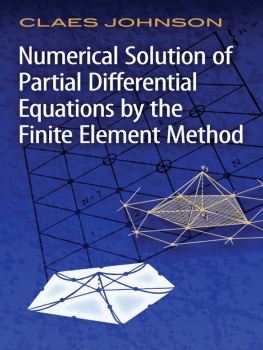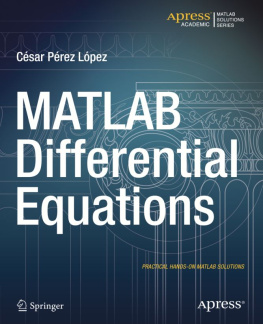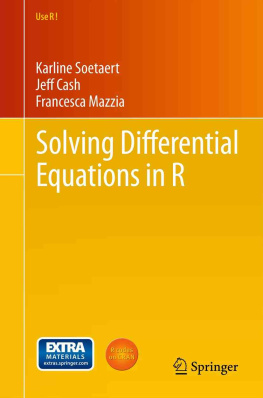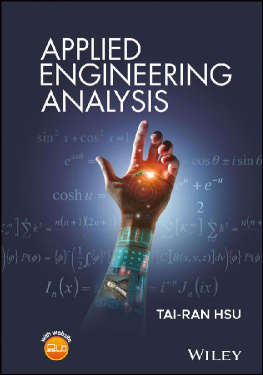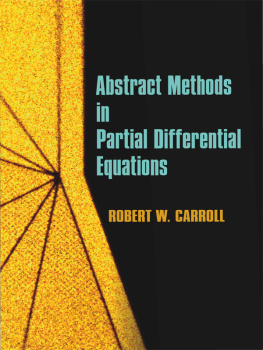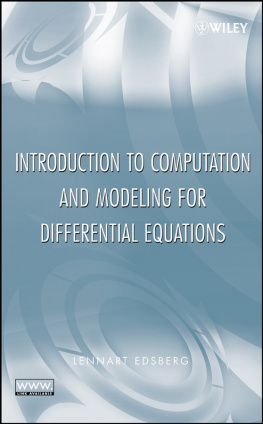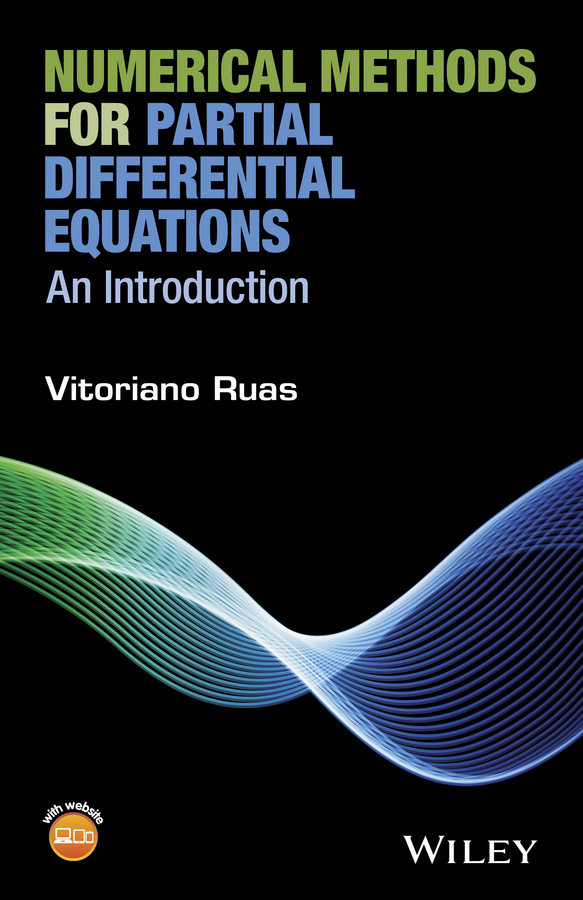
Table of Contents
List of Tables
- Chapter 1
- Chapter 5
- Chapter 7
List of Illustrations
- Chapter 1
- Chapter 2
- Chapter 3
- Chapter 4
- Chapter 5
- Chapter 6
- Chapter 7
Guide
Pages
NUMERICAL METHODS FOR PARTIAL DIFFERENTIAL EQUATIONS
AN INTRODUCTION FINITE DIFFERENCES, FINITE ELEMENTS AND FINITE VOLUMES
Vitoriano Ruas
Sorbonne Universites, UPMC - Universite Paris 6, France
This edition first published 2016
2016 John Wiley & Sons Ltd
Registered office
John Wiley & Sons Ltd, The Atrium, Southern Gate, Chichester, West Sussex, PO19 8SQ, United Kingdom
For details of our global editorial offices, for customer services and for information about how to apply for permission to reuse the copyright material in this book please see our website at www.wiley.com.
The right of the author to be identified as the author of this work has been asserted in accordance with the Copyright, Designs and Patents Act 1988.
All rights reserved. No part of this publication may be reproduced, stored in a retrieval system, or transmitted, in any form or by any means, electronic, mechanical, photocopying, recording or otherwise, except as permitted by the UK Copyright, Designs and Patents Act 1988, without the prior permission of the publisher.
Wiley also publishes its books in a variety of electronic formats. Some content that appears in print may not be available in electronic books.
Designations used by companies to distinguish their products are often claimed as trademarks. All brand names and product names used in this book are trade names, service marks, trademarks or registered trademarks of their respective owners. The publisher is not associated with any product or vendor mentioned in this book.
Limit of Liability/Disclaimer of Warranty: While the publisher and author have used their best efforts in preparing this book, they make no representations or warranties with respect to the accuracy or completeness of the contents of this book and specifically disclaim any implied warranties of merchantability or fitness for a particular purpose. It is sold on the understanding that the publisher is not engaged in rendering professional services and neither the publisher nor the author shall be liable for damages arising herefrom. If professional advice or other expert assistance is required, the services of a competent professional should be sought.
The advice and strategies contained herein may not be suitable for every situation. In view of ongoing research, equipment modifications, changes in governmental regulations, and the constant flow of information relating to the use of experimental reagents, equipment, and devices, the reader is urged to review and evaluate the information provided in the package insert or instructions for each chemical, piece of equipment, reagent, or device for, among other things, any changes in the instructions or indication of usage and for added warnings and precautions. The fact that an organization or Website is referred to in this work as a citation and/or a potential source of further information does not mean that the author or the publisher endorses the information the organization or Website may provide or recommendations it may make. Further, readers should be aware that Internet Websites listed in this work may have changed or disappeared between when this work was written and when it is read. No warranty may be created or extended by any promotional statements for this work. Neither the publisher nor the author shall be liable for any damages arising herefrom.
Library of Congress Cataloging-in-Publication Data
Names: Ruas, Vitoriano, 1946- author.
Title: Numerical methods for partial differential equations : an introduction / Vitoriano Ruas.
Description: Chichester, West Sussex, United Kingdom : John Wiley & Sons, Inc., [2016] | Includes bibliographical references and index.
Identifiers: LCCN 2016002914 (print) | LCCN 2016007091 (ebook) | ISBN 9781119111351 (cloth) | ISBN 9781119111375 (pdf) | ISBN 9781119111368 (epub)
Subjects: LCSH: Differential equations, Partial. | Boundary value problems.
Classification: LCC QA374 .R83 2016 (print) | LCC QA374 (ebook) | DDC 515/.353dc23
LC record available at http://lccn.loc.gov/2016002914
A catalogue record for this book is available from the British Library.
A Alex, Lo & Romy
En hommage mes matres de lcole parisienne danalyse numrique
Preface by Eugenio Oate
Numerical methods have become nowadays indispensable tools for the quantitative solution of the differential equations that express the behaviour of any system in the universe. Examples are found in the study of engineering systems such as mechanical devices, structures and vehicles, and of biological and medical systems such as human organs, prosthesis and cells, to name a few. Numerical methods are applicable to the solution of differential equations that represent mathematical models of an underlying real system. These models are conceptual representation of reality using mathematics. It is interesting that in mechanics (which governs the behaviour of all engineering systems and many problems in physics) these models are obtained by simple balance (or equilibrium) laws applied to infinitesimal parts of the continuous system and its boundary. The beauty of the modelling process is that many times the resulting differential equations, even if they have the same mathematical form, are applicable to many different real life problems. A typical example is the Poisson equation that is used to represent the behaviour of such different problems as the heat conduction in a body, the seepage flow in a porous media, the flow of an incompressible fluid and the torsion of a bar, among others. Clearly a mathematical model represents a simplification of reality using geometrical data and physical properties of the constituent materials that are close enough to those of the real system under study and at the same time help to express its behaviour in mathematical form. On the other hand, the numerical solution of the resulting governing differential equations of the mathematical model introduces a series of simplifications. Numerical methods work on discretized forms of the model geometry which is split into simple geometrical entities, such as triangles and tetrahedra in two (2D) or three (3D) dimensions, respectively, as is typical in finite element or finite volume procedures or Cartesian grids, as is done in finite difference methods. The balance equations for each discretization unit (an element, a volume or a cell) are obtained in terms of a finite set of parameters and then used to obtain (assemble) the behaviour of the whole system by expressing the satisfaction of the balance laws at all the discrete points of the discrete system. The so-called discretization process leads to a system of algebraic equations that typically involve several millions of unknown parameters for real life problems. These equations are solved in modern computers using state of the art of computer science technology. This explains why numerical methods are many times referred to as computational methods. The two terms are in fact equivalent. The simplifications made along the modelling and numerical solution path lead to a final quantitative solution that is only approximate. The quantification of the modelling and numerical solution errors are topics of much current research. The timely book of Professor Ruas fits precisely in the context described above as it provides a comprehensive insight on the derivation and best use of numerical methods for solving a number of differential equations that govern a wide class of practical problems. The emphasis is in providing the reader with the knowledge and tools to assess the performance and reliability of a particular numerical method via the study of its stability, consistency, convergence and approximation order. The book uses simple one-dimensional (1D) problems for introducing the three basic numerical methods addressed in the book: finite differences, finite elements and finite volumes. A quantitative reliability analysis of the three families of methods is presented as well as the extension of the methods to transient situations and 2D problems. A convergence analysis for a well know multidimensional scalar problem (the Poisson equation) is also included. The book devotes a chapter to presenting higher order Lagrange finite elements and the extension of the finite element method to 3D problems. A final chapter describes a number of interesting topics such as the numerical solution of bi-harmonic equations in rectangles, the solution of the advection- diffusion equation, an outline of aposteriori error estimation and adaptive numerical solution procedures and a brief introduction to the numerical solution of nonlinear partial differential equations. Other numerical techniques are briefly presented in the Appendix.
Next page

